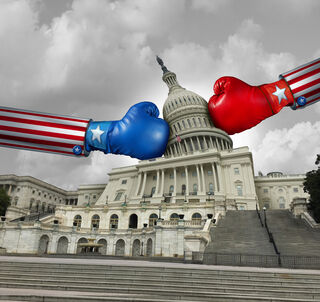Fear
How Negative Partisanship Is the Enemy, Not One Another
Increased negative partisanship threatens our democracy and prosperity.
Posted November 20, 2020

Disclaimer: I don't claim that what I say is totally "true," because the truth is elusive in this complicated world. Rather, I'm offering some ideas to help perceive the world, others, and ourselves in a manner that opens pathways for change and growth.
Major news organizations, such as the Associated Press and Fox News, have declared Joe Biden the winner of the contentious 2020 presidential election. However, at the moment, the runner up, President Donald Trump, has yet to concede and continues to claim the election was rigged despite evidence that it was the most secure in U.S. history. Biden won the election with the most votes in United States history (79,695,885). Interestingly, President Donald Trump received the second most votes in U.S. history (73,712,283).
Many liberals cannot conceive of how many people voted for Trump, despite a long list of grievances. Conversely, Trump supporters will happily point out to the many shortcomings of President Barack Obama, "Crooked" Hillary Clinton, and "Sleepy Joe" Biden. It's as if one half of the country thinks that the other half is some combination of ignorant, blind, dumb, biased, irrational, close-minded, uneducated, racist, unpatriotic, disloyal, or even downright evil.
The Rise of Negative Partisanship
"I can't understand what makes a man hate another man. Help me understand." —from the song, "People Are People" by Depeche Mode
The reasons we vote for particular candidates and parties are complicated, of course. It's a form of reductionism to point to one or two particular factors to explain such complexities. With that caveat in mind, the rise of negative partisanship is one major factor that has been playing an increasing role in American politics. That is, most voters are not motivated to vote for their party because they like their party or candidate so much. They are voting for their candidate out of fear, hatred, or revulsion of the other side's candidate.
We did not always hold such negative views of the opposing party. About 40 years ago, most Americans held positive views of their own party, and almost 50% of people viewed the opposing party as favorable. While most people continue to view their own party as favorable, almost 90% view the opposing party as unfavorable.
How did this happen? One factor that might contribute to the rise in negative partisanship is that Democrats and Republicans used to be united in their hatred of a common enemy. Between about 1950 and 1990, our common enemy was communism and, in particular, the Union of Soviet Socialist Republics. In the decades following the dissolution of the USSR in 1991, Americans have replaced their shared hatred of the USSR with their shared hatred of one another.
In his recent book, Why We Are Polarized, Ezra Klein describes an additional factor that plays into the increasing negative partisanship we are seeing in America. Historically, both Republicans and Democrats would try to woo undecided, independent, or swing voters to help them win elections. However, identifying these swing voters, crafting a message to appeal to them, and motivating them to vote was difficult, time-consuming, and costly. Both Republicans and Democrats realized that a better strategy was to appeal to their base and motivate a higher percentage of them to vote.
How does one motivate their base to vote? It's through eliciting strong negative feelings toward the other party. More specifically, eliciting fear of the other side is a way to rouse one's base to vote for one's candidate.
Using Fear to Stoke the Fires of Negative Partisanship
"The enemy is fear. We think the enemy is hate, but it is fear." — Mahatma Gandhi
"Fear is the path to the Dark Side. Fear leads to anger. Anger leads to hate. Hate leads to suffering." — Yoda, from Star Wars Episode I: The Phantom Menace
"In time we hate that which we often fear." — William Shakespeare, from Antony and Cleopatra
Negative partisanship is based on igniting and fanning the fires of fear. One side depicts the other as a threat to one's life, safety, happiness, freedom, survival, family, community, and the very country they love. These days, both sides dread that the other will destroy America. If you can get your side to believe that the other side or candidate will destroy what you love and hold dear, you can count on their votes. This is at the heart of negative partisanship.
Viewing Politics Through an Evolutionary Lens
We might scratch our heads and wonder why our political parties are becoming based on so much fear and hate. If we look at our political system through the lens of evolution, it makes more sense. The survival instinct is fundamental to our existence. The emotion of fear evolved because it helps us deal with threats to our survival through fight, flight, or freeze. It is easy for this fear to turn into hate when we view others as threats to our existence. Those we hate become our enemies.
If we think of a political party as an entity, eliciting fear to galvanize support against a perceived enemy is completely understandable. Evolution isn't about fairness, justice, or even reality. It is about what helps us, and our tribe, survive. To paraphrase Gordon Gecko, the corrupt business tycoon and cooperate raider from the movie Wall Street, "Fear, for lack of a better word, is good. Fear is right. Fear works." If you can get your side to view the other side as a threat, they become the enemy that needs to be defeated at virtually any cost.
Fear explains why Trump could get away with saying and doing things that no other politician in recent times could. He is masterful at eliciting fear, which galvanizes support for him. Some Republicans refuse to speak out against Trump for fear of his reprisal, being attacked by his base, or losing re-election. Yet, Democrats tap into fear as well. They elicit fear of authoritarianism, racism, intolerance, climate change, losing the soul of America, Republicans, and Trump himself.
Why Our Common Enemy Is Negative Partisanship
Although it works in the short run, the increased negative partisanship is a formidable problem that Americans share. Here's a reality that should motivate both the left and right toward change. Americans' trust in our government has fallen from 77% in 1964 to a near-historic low of 17% in 2019. Creating partisan fear, anger, and hate sows the seeds of our own destruction.
Low trust in one another, our politicians, and our foundational institutions decreases social capital and our happiness in society. Solving societal problems like this pandemic, health care, rising educational costs, national debt, climate change, and so on necessitates cooperation and compromise. When our parties don't trust one another, we get political gridlock. However, how can we trust one another if we view one another as enemies who are out to destroy us?
We need to collectively realize the truth that this negative partisanship is a huge threat to America's growth and progress. We will suffer from the "sins" of our mutual distrust, fear, and hatred of one another if we don't make changes. Indeed, Republicans and Democrats share a common enemy that needs to be defeated — the enemy within.
The Takeaway?
America is becoming increasingly polarized, with negative partisanship being one of the root causes of this shift. Partisan battles are becoming more heated, bitter, and malicious. When we view the other side as a threat to our survival, we can rationalize almost any means to defeat them. Denial, deceit, lying, hatred, and even violence can all be justified when we believe our survival is at stake. Loyalty to our party and leaders becomes the supreme good because we believe they are the means of our salvation.
The problem is that extreme partisan biases do not fit with reality. The world is not dualistic and cannot be neatly divided into good people and bad people or right and wrong. Our problems in America do not begin with the other side. They are not the true enemy. The true enemy is negative partisanship and the feelings that accompany it. Unless we begin to collectively realize this, we will continue down the dark road that vilifying our fellow Americans takes us down.
What's the first step toward addressing this shared problem? It lies within ourselves. When we feel fear, anger, and hatred rise within us toward the other side, that's where we start. We need to change the ways in which we view the other side.
They, like us, think they are correct and are doing the best they can. Like us, they want to be happy and want America to be a happy, prosperous nation. They just have different ideas about what that looks like. We need to learn to disagree agreeably instead of viewing the other side as an enemy that is to be feared and hated. When we liberate ourselves from this true "enemy," perhaps then we can better fulfill the promise of our United States motto of e Pluribus Unum: Out of many, one.




